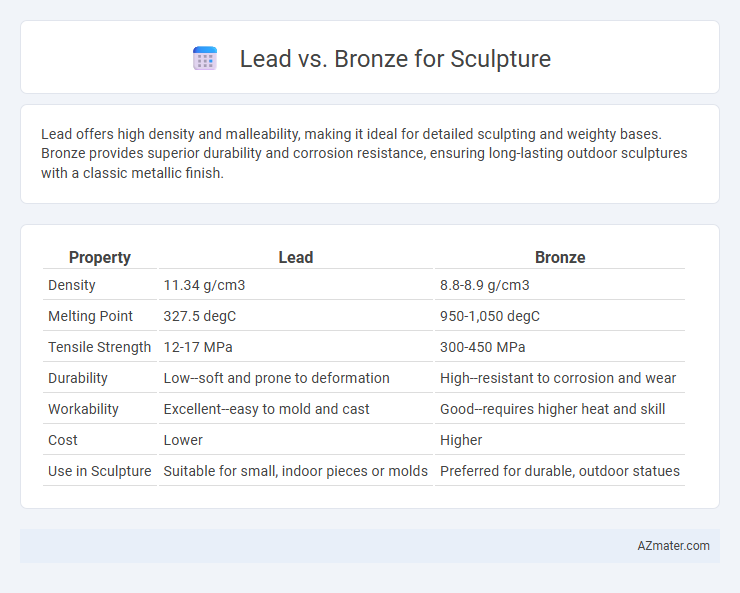Lead offers high density and malleability, making it ideal for detailed sculpting and weighty bases. Bronze provides superior durability and corrosion resistance, ensuring long-lasting outdoor sculptures with a classic metallic finish.
Table of Comparison
| Property | Lead | Bronze |
|---|---|---|
| Density | 11.34 g/cm3 | 8.8-8.9 g/cm3 |
| Melting Point | 327.5 degC | 950-1,050 degC |
| Tensile Strength | 12-17 MPa | 300-450 MPa |
| Durability | Low--soft and prone to deformation | High--resistant to corrosion and wear |
| Workability | Excellent--easy to mold and cast | Good--requires higher heat and skill |
| Cost | Lower | Higher |
| Use in Sculpture | Suitable for small, indoor pieces or molds | Preferred for durable, outdoor statues |
Introduction to Sculpture Materials: Lead and Bronze
Lead and bronze are traditional materials extensively used in sculpture, each offering unique properties that influence artistic expression. Lead is valued for its softness, malleability, and weight, allowing detailed yet heavy sculptures, while bronze is prized for its strength, durability, and ability to capture fine details through casting processes. The choice between lead and bronze often depends on the desired aesthetic, longevity, and structural demands of the sculpture.
Historical Use of Lead and Bronze in Sculpture
Lead and bronze have been historically favored materials in sculpture due to their unique properties and availability. Bronze, an alloy of copper and tin, was widely used since ancient times for its durability, ability to capture fine details, and resistance to corrosion, exemplified by classical statues such as the Riace Warriors. Lead, being softer and more malleable, was often employed in smaller, detailed sculptures or as a core material beneath other metals, though its toxicity limited extensive use compared to bronze in monumental works.
Physical Properties: Lead vs Bronze
Lead has a higher density (11.34 g/cm3) compared to bronze (approximately 8.8 g/cm3), making lead significantly heavier and softer, which allows for easier carving but less structural strength. Bronze, an alloy primarily of copper and tin, offers superior hardness and durability with greater tensile strength and corrosion resistance, ideal for detailed and long-lasting sculptures. The melting point of lead is lower (327.5degC) than bronze (around 950degC), influencing casting techniques and finish quality in sculptural applications.
Aesthetic Qualities and Surface Finish
Lead offers a dense, smooth surface ideal for capturing fine details in sculptures, giving a subtle matte or slightly reflective finish that enhances intricate textures. Bronze provides a warm, rich patina that develops over time, creating a visually dynamic surface with depth and character, often polished to a high sheen or left with a natural, aged look. The choice between lead and bronze heavily influences the sculpture's aesthetic appeal, with lead favoring softer, muted tones and bronze delivering vibrant, enduring lusters.
Durability and Longevity in Outdoor Settings
Lead sculptures exhibit exceptional weather resistance due to their dense, non-porous nature, making them highly durable in outdoor settings. Bronze offers superior longevity through natural patination that protects against corrosion, ensuring sculptures can withstand harsh environmental conditions for centuries. Both materials are favored for outdoor art, with bronze providing enhanced structural strength and lead offering unique malleability for detailed designs.
Safety and Toxicity Considerations
Lead poses significant safety and toxicity risks in sculpture due to its high toxicity and potential for causing lead poisoning through inhalation or ingestion of dust and fumes. Bronze, an alloy primarily of copper and tin, is much safer for sculptors as it does not release harmful substances under normal working conditions, reducing health hazards. Proper ventilation and protective equipment are essential when working with lead, whereas bronze offers a safer alternative for both artists and the environment.
Workability and Casting Techniques
Lead offers high malleability and low melting point, making it easier to shape and cast intricate sculpture details using traditional sand or gravity casting methods. Bronze, an alloy of copper and tin, provides superior durability and tensile strength, requiring higher temperatures and investment casting techniques for fine art sculptures. While lead allows rapid prototyping due to its softness, bronze remains the preferred choice for long-lasting works exposed to outdoor conditions.
Cost and Availability of Materials
Lead is generally more expensive than bronze due to its lower demand and higher toxicity, which requires careful handling and disposal, increasing overall costs. Bronze, an alloy primarily of copper and tin, remains widely available and cost-effective because of its extensive use in art and industry, ensuring steady supply chains. The choice between lead and bronze for sculpture often hinges on budget constraints and material accessibility, with bronze favored for its durability and market availability despite a potentially higher base cost.
Conservation and Maintenance Challenges
Lead sculptures require careful conservation due to their susceptibility to corrosion, particularly white oxide formation that can cause surface degradation. Bronze, an alloy primarily of copper and tin, often develops a green patina called verdigris, which can accelerate metal deterioration if not properly managed through regular cleaning and protective coatings. Both materials demand specialized maintenance strategies to prevent structural damage and preserve aesthetic integrity over time.
Choosing the Right Material for Modern Sculptors
Lead offers sculptors exceptional malleability and a low melting point, facilitating intricate detailing and ease of casting for modern art pieces. Bronze provides superior durability and a timeless aesthetic with its resistance to corrosion, making it ideal for outdoor installations and long-lasting sculptures. Modern sculptors must weigh lead's workability against bronze's strength and longevity to select the optimal material for their artistic vision and installation environment.

Infographic: Lead vs Bronze for Sculpture
 azmater.com
azmater.com